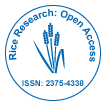当社グループは 3,000 以上の世界的なカンファレンスシリーズ 米国、ヨーロッパ、世界中で毎年イベントが開催されます。 1,000 のより科学的な学会からの支援を受けたアジア および 700 以上の オープン アクセスを発行ジャーナルには 50,000 人以上の著名人が掲載されており、科学者が編集委員として名高い
。オープンアクセスジャーナルはより多くの読者と引用を獲得
700 ジャーナル と 15,000,000 人の読者 各ジャーナルは 25,000 人以上の読者を獲得
インデックス付き
- 索引コペルニクス
- Google スカラー
- Jゲートを開く
- アカデミックキー
- 電子ジャーナルライブラリ
- レフシーク
- 研究ジャーナル索引作成ディレクトリ (DRJI)
- ハムダード大学
- エブスコ アリゾナ州
- OCLC-WorldCat
- 学者の舵取り
- SWBオンラインカタログ
- 仮想生物学図書館 (vifabio)
- パブロン
- ユーロパブ
役立つリンク
オープンアクセスジャーナル
このページをシェアする
抽象的な
Resource Use, Profitability and Externality in Aerobic Vis-A-Vis Conventional Rice Cultivation in Karnataka, India
Thejaswi Kumar
The study was undertaken to analyze resource use, economics of cultivation and externality associated with Aerobic Rice
Cultivation (ARC) in comparison with Conventional Rice Cultivation (CRC) in Eastern Dry Zone of Karnataka. Snow ball sampling
technique was adopted to collect primary data from 50 farmers each practicing ARC and CRC. The per hectare gross returns
was higher in CRC (₹ 1,16,827/ha) compared to aerobic rice cultivation (₹ 1,00,664/ha) since the grain yield was higher in CRC.
The aerobic rice cultivation (ARC) was profitable as it generated higher net returns (₹ 24,653/ha) compared to conventional
paddy cultivation (₹ 11,046/ha) because of lower cost of cultivation. ARC was sustainable compared to conventional method
as resources were optimally used. In addition, ARC resulted in positive externality to the tune of ₹ 7714 per hectare over CRC.
Human work was the significant expense part in both ARC and CRC Among the costs in ARC, human labour cost accounted
nearly 40 per cent because of high labour requirement for weeding. Imputed irrigation cost was higher in CRC than ARC where
water requirement was saved up to 63 per cent. The examination uncovered the predominance of ARC over CRC with regards
to cost, net returns and positive externality. Hence, the study helps policy makers and stakeholders in extensive promotion of the
technology.

 English
English  Spanish
Spanish  Chinese
Chinese  Russian
Russian  German
German  French
French  Portuguese
Portuguese  Hindi
Hindi